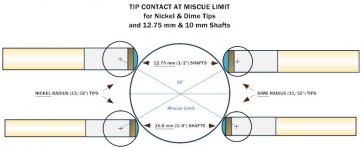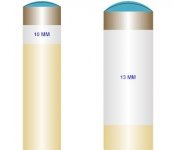ajhnnyz86...The contact area between the tip and ball is the same size, regardless of tip size, or shape...about 1/8", or 3mm. Shape of the tip doesn't matter. There's no such thing as a "too round" tip...round hits round.
Scott Lee
www.poolknowledge.com
Scott Lee
www.poolknowledge.com
dime because someone said it results in less deflection. perhaps, the less contact area means less friction so it bends towards the ball less which is one part of deflection. it only does this for an extremely short amount of time before it bends away from the ball.
its contact point is closer to where i point.
also i only have a dime shaper


